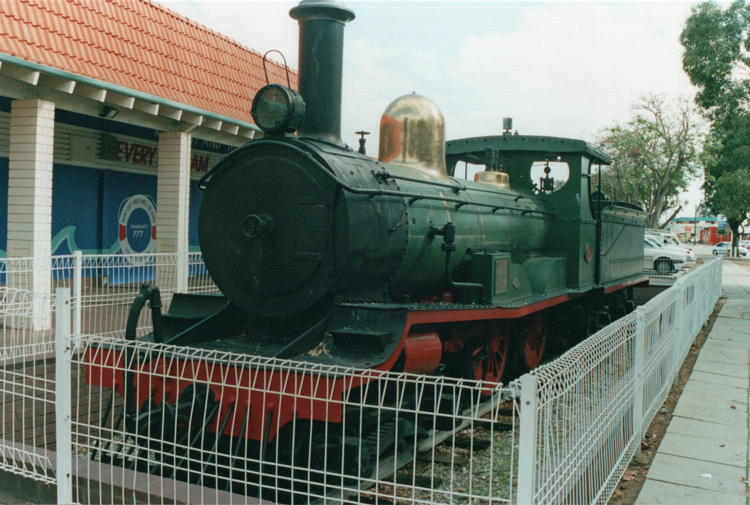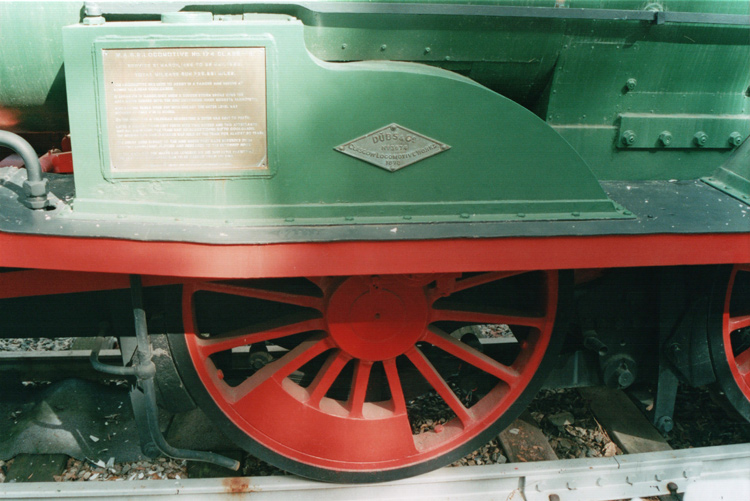|
|
R 174
The Railway Museum, Bassendean
|
|

The webmaster visited the Midland Centrepoint Shopping
Centre in search of R 174 on 9 May 2002.
Here is a scanned photo view of the loco
as I found her lazing in the car park.
The loco exhibits beautiful period details such as a
copper-top chimney, and polished brass on the steam dome cover and safety valve
bonnet.
|
Builder
|
Dubs
& Co,
Glasgow, Scotland
|
|
Builder’s Number & Year
|
3674
of 1898
|
|
Wheel Arrangement
|
4-4-0
|
|
R 174 is the survivor of 24 R-class
locomotives supplied by Dubs & Co., Glasgow to the Western Australian
Government Railways (WAGR) for express passenger duties, entering service
between 1897 and 1899. The 4-4-0 configuration for passenger work was
already proven to the WAGR by the smaller T-class locomotives of 10 years
earlier, the first 6 examples built by Beyer Peacock & Co. in 1887 and
a further 4 from Kitson & Co. built in 1888. The WAGR also operated 2
P-class 4-4-0 locos built by James Martin & Co. of Gawler in 1896 as
copies of the South Australian Railways Z-class.
From 1909 onwards, a total of 14 R-class
locomotives (including preserved example R 174) were converted to 4-4-2
‘Atlantic’ wheel arrangement to reduce their axle-load, thus permitting use
on routes with lighter rails. These modified engines were classed ‘Ra’. It
seems this modification must have relatively straightforward because
several locos reverted to 4-4-0, only to be later converted to 4-4-2 for a
second time!
R 174 achieved a degree of fame in 1907 as
one of three locomotives engaged to haul an emergency express conveying
divers and rescue equipment from Fremantle to Coolgardie, following a miner
becoming trapped in the Westralia mine at Bonnievale which had flooded
following a sudden storm. Using a long air hose rushed from Perth, the
divers successfully rescued the man - Modesto ‘Charlie’ Varischetti - after
6 days trapped in an underground air pocket. History records that
Varischetti survived his ordeal and the WAGR was recognised for quickly
organising the ‘cannonball run’ to Coolgardie.
While most R-class locos were withdrawn in
the mid-1920’s, six examples survived into the 1940’s. R 174 was among
these and running in 4-4-2 configuration when first withdrawn in 1947. It
was reinstated in 1948 and was the last class member in traffic when
finally retired in 1953. While many other wonderful steam locomotive
designs became extinct throughout Australia in the 1950’s, fortunately R
174 was saved for posterity, ostensibly due to its role in the 1907 mine
disaster and reflecting WAGR pride in their response. The loco was rebuilt
from 4-4-2 to 4-4-0 configuration, restored to original condition, and then
plinthed outside the Railway Institute Library at Midland Junction. At some
stage commemorative brass plaques were mounted on each sandbox recording
the loco’s service history and role in the 1907 mine rescue.
In 1972 the loco moved to a new plinth at
the Midland Centrepoint Shopping Centre. (I believe this shopping precinct
was built on former Midland Railway land at Midland Junction, so perhaps
the loco’s movement was necessary due to redevelopment of its former site.)
Photos on this page show R 174 as I found her at the Midland Centrepoint
Shopping Centre on 9 May 2002; it was difficult to photograph from some
angles as it was positioned close to the shop building. In those days I
used a film SLR camera and only took 3 shots to preserve expensive film,
whereas nowadays I would take many digital shots from all angles!
The Midland Centrepoint Shopping Centre has
itself since been redeveloped. Fortunately, R 174 was donated to Rail
Heritage WA for display at The Railway Museum,
Bassendean, where it arrived on 13 March 2011 - a
very fitting home for this important historic relic and survivor.
Passenger 4-4-0 locomotives were once a
significant part of the Australian railway scene, represented by various UK
builders across narrow, standard and broad gauges, together with classic
American examples from Baldwin. Alas most of these locos did not last long
enough to pass into the preservation era. From a ferroequinology point of
view, surviving examples include:
·
Midland Railway Company (WA) B 6
·
South Australian Railways Z-class replica Z 199
·
Tasmanian Government Railways A-class A 4
·
NSWGR 12 & 13-class, including 1210
Among the 4-4-0
types consigned to history are the beautiful and elegant A and AA classes
of the Victorian broad gauge, the high-stepping SAR S-class (last two
scrapped in September 1961 and spurring formation of the Mile End Railway
Museum) and American types such as the QGR A12-class with their classic
Baldwin ‘wild west’ styling.
|
|

Detail of R 174's driving wheels, splasher & builder's
plate. 9 May 2002.
The plaque on the sandbox provides the loco’s service
details together with a description of the 1907 mine rescue train.

Detail of the Dubs & Co builder’s plate, from scanned
print photo dated 9 May 2002.
(Alas the historical plaque details on the sandbox were not
legible upon post-processing.)

R 174 plinthed at the Railways Institute, Midland, as seen
on 22 September 1962.
At that stage the loco was displayed in a
garden setting under a weather roof, but the brass plaque on the sandbox is not
evident.
Image used with permission of the wonderful
Rail Heritage WA archive:
http://railheritagewa.org.au/archive_scans/displayimage.php?pid=10536
(Image reference T01927, original photographer E. Woodland.)

A later photo of R 174, plinthed at the Midland Railway
Institute in 1972 and freshly repainted in lined blue livery.
It appears to be in the same location as
the photo above, but the weather roof, tree and garden setting has been
replaced by a car park.
Image used with permission of the Rail
Heritage WA archive:
http://railheritagewa.org.au/archive_scans/displayimage.php?pid=29226
(Image reference T06745, original photographer N. Pusenjak.)

R 174 displayed in unlined black livery at the Railway
Museum, Bassendean on 21 July 2013.
It had recently been restored and
repainted for a documentary by an Italian company about the rescue of the
entrapped miner Varischetti.
The brass plaque is no longer displayed
on the sandbox.
Image used with permission of the Rail
Heritage WA archive:
http://railheritagewa.org.au/archive_scans/displayimage.php?pid=14262
(Image reference P13330, original photographer Graham Watson.)

T 170 ‘The Gordon’ (Kitson b/n 3106 of 1888, from a Beyer
Peacock design) stored at Midland Workshops, 05 September 1955.
Withdrawn in 1948, the veteran 4-4-0 is
prominently marked “Not to be cut up” on the cabside, but alas it did not
escape that fate.
A change of plans, or perhaps the Midland
Workshops scrap crew just had trouble following instructions?
Image used with permission of the Rail
Heritage WA archive:
http://railheritagewa.org.au/archive_scans/displayimage.php?pid=21872
(Image reference P15663, original
photographer R. Taylor.)
References
|
a
|
A. Gunzburg
'A history of WAGR steam locomotives',
published
by ARHS (Western Australian Division) 1984.
Pages 63 –
65.
|
|
b
|
Gray. W.
K., 'Guide to Rail Transport Museum, Bassendean, Western Australia',
Australian Railway
Historical Society W. A. Division, First Edition November 1999.
|
|
c
|
Rail
Heritage WA website www.railheritagewa.org.au,
'What's
New’ page,
retrieved
12 February 2015.
|
|
d
|
Rail
Heritage WA website, Exhibits page: ‘R class’:
https://www.railheritagewa.org.au/museum/locos/pages/r_steam.php
retrieved 6
January 2023
|
|
e
|
Western
Australian Museum website, ‘A Miraculous Rescue’ page:
https://museum.wa.gov.au/explore/wa-goldfields/dangerous-life/miraculous-rescue
retrieved 5
January 2023.
|
Page updated: 7 March 2023






